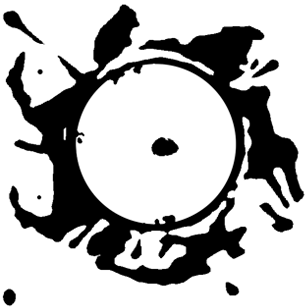The more I deal with issues of ethnicity, the more I want to confuse the hell out of people when they meet me. By “dealing” I don’t mean to say “struggling,” “grappling,” or anything like that. I’m comfortable and proud of my heritage, so I don’t have much drama for you on that arena. What I mean by “dealing” is this: when I meet people in the Art World, and we start talking, I see a tendency of them wanting to put me in a certain category as soon as they meet me. I suppose this is so that they can proceed with their set of assumptions and preconceived notions as they talk to me. It’s almost like some sort of tagging game where they are chasing me around with a red tag that says “Hispanic Artist.” Don’t worry, I’ll explain.
Ever since this show at the museum opened, I’ve been meeting a lot of people on and off the museum. When they see the work, they enjoy it, and simply ask me how I came to choose my iconography and symbols. No problem there, that’s just interest, or curiosity. Only a few individuals get stuck on the surface of it, and question me about what they see as a contradiction between some sort of “Asian-ness” and my “Hispanic-ness.” But when I describe it, without them having seen it... O M G! You should see their faces as they struggle with me. This is actually a great sign for me, because (a) it lets me know that the content of my work is not something that is easy to accept, in other words, it is foreign to people, and (b) the fact that the work itself reduces (if not, eliminates altogether) this kind of reaction, tells me that I must be doing something right to bridge that gap.
I think that the conflict arises due to two facts: people’s obsession with the self (specifically their selves), and the constant set of justifications that people construct to justify such notions. (I should clarify that I don’t believe in the existence of a self,* and that, to a large degree, my work deals with this subject). When we believe that we “are,” then we have to believe that others “are” as well. This has two effects on personality: we draw the ubiquitous “me/them border,” and then we have to upkeep it. Anything that would contradict that notion is an attack on that imaginary border, and therefore, an attack on those it is meant to protect. Within such a worldview, things can only mean ONE thing. There can only be one principle, (one way of doing things, etc, etc.) because if one thing can be many things, then it is not elemental, essential, or special. To be more precise: it is not an entity. That would mean there are only events and processes in existence. This can be quite scary for many people, because they don’t have the tools to deal with such a concept.
In art, this reflects itself in the overwhelming dominance of similes over metaphors. Most art works consist of the simple formula: x means y. “You are you, I am me, he is he. And if I’m feeling frisky, maybe I’ll be this or I'll be that. But I will always BE.”
But what happens when existence gets defined in a series of things you are exactly NOT, or in a multitude of things you are at the same time, therefore becoming none of them? Metaphors (or at least good metaphors) function at a series of levels, and move within these. Most people cannot handle such a concept, because it leads to doubt of their own self. Jung said that one of the reasons that monotheistic religions hesitate to name their gods, or constantly refer to them by adjectives, is because knowing somebody’s name is seen as having an advantage over them. In other words, non-definable things are seen as threatening, definable ones are seen as manageable. If you think about it, the more above us that somebody is, the less we use their names. Think of what you call your parents, your employer, your rulers, your gods. Now think of what you call your siblings, your friends, your children, your employees. Get it?
In the same way, our arrogance and self-gratification has led us to favor artworks that reinforce our view of the universe and ourselves as we see it, or want to see it. We want objects that we can name, (but not too easily, of course) so that we can feel some sense of achievement. Originality is confused with stylistic shenanigans, and truly innovative work gets ignored all too often.
In my case, when people can’t define me easily, this can bring some sort of aversion. They can’t match my views, or capabilities, with their idea of others like me, and become uneasy.
One of these people who I’m talking about quipped, “And where is the Catholic component of your work reflected?”
He must have been assuming there is one, or else he would have asked, “Is there a Catholic component in your artwork somewhere?” Because then, I would have replied “Well, if there is one, please show it to me, so that I can do something about it the next time!” >:)
*For more on the illusion of the self, and the research being done on this by various neurologists and psychologists please listen to Radio Lab’s excellent show on the subject.
Tuesday, November 21, 2006
Subscribe to:
Post Comments (Atom)

1 comment:
Nude beaches [url=http://celebritiespics.blogreaction.com] naked video clips[/url] Naked celeb
Post a Comment